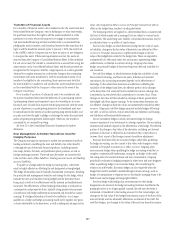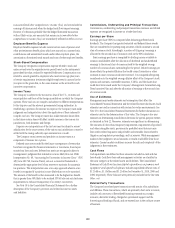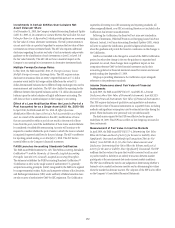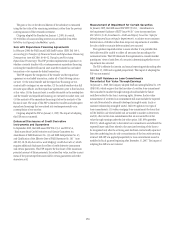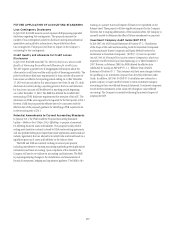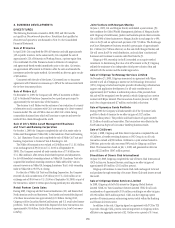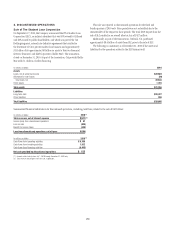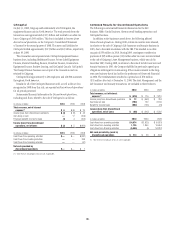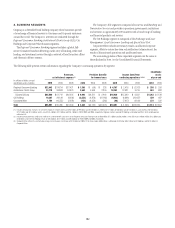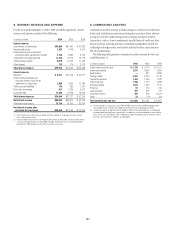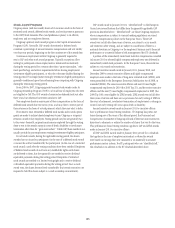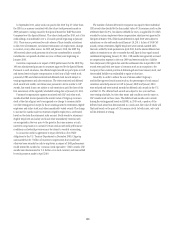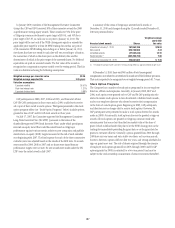Citibank 2010 Annual Report Download - page 179
Download and view the complete annual report
Please find page 179 of the 2010 Citibank annual report below. You can navigate through the pages in the report by either clicking on the pages listed below, or by using the keyword search tool below to find specific information within the annual report.177
FUTURE APPLICATION OF ACCOUNTING STANDARDS
Loss-Contingency Disclosures
In July 2010, the FASB issued a second exposure draft proposing expanded
disclosures regarding loss contingencies. This proposal increases the
number of loss contingencies subject to disclosure and requires substantial
quantitative and qualitative information to be provided about those
loss contingencies. The proposal will have no impact on the Company’s
accounting for loss contingencies.
Credit Quality and Allowance for Credit Losses
Disclosures
In July 2010, the FASB issued ASU No. 2010-20, Disclosures about Credit
Quality of Financing Receivables and Allowance for Credit Losses.
The ASU requires a greater level of disaggregated information about the
allowance for credit losses and the credit quality of financing receivables. The
period-end balance disclosure requirements for loans and the allowance for
loans losses are effective for reporting periods ending on or after December
15, 2010 and are included in this annual report (see Notes 16 and 17), while
disclosures for activity during a reporting period in the loan and allowance
for loan losses accounts will be effective for reporting periods beginning
on or after December 15, 2010. The FASB has deferred the troubled debt
restructuring (TDR) disclosure requirements that were part of this ASU. The
disclosures on TDRs were supposed to be required for the first quarter of 2011.
However, FASB has postponed the effective date to be concurrent with the
effective date of the proposed guidance for identifying a TDR, expected to be
in the second quarter of 2011.
Potential Amendments to Current Accounting Standards
In January 2011, the FASB issued the Proposed Accounting Standards
Update—Balance Sheet (Topic 210): Offsetting, to propose a framework
for offsetting financial assets and liabilities. This proposal would prohibit
netting most derivative contracts covered by ISDA master netting agreements
and also prohibit netting most repurchase/resale agreements under standard
industry agreements that are allowed to be netted today and would result in a
significant gross-up of assets and liabilities on the balance sheet.
The FASB and IASB are currently working on several joint projects,
including amendments to existing accounting standards governing financial
instruments and lease accounting. Upon completion of the standards, the
Company will need to re-evaluate its accounting and disclosures. The FASB
is proposing sweeping changes to the classification and measurement of
financial instruments, hedging and impairment guidance. The FASB is also
working on a project that would require all leases to be capitalized on the
balance sheet. These projects will have significant impacts for the Company.
However, due to ongoing deliberations of the standard-setters, the Company is
currently unable to determine the effect of future amendments or proposals.
Investment Company Audit Guide (SOP 07-1)
In July 2007, the AICPA issued Statement of Position 07-1, “Clarification
of the Scope of the Audit and Accounting Guide for Investment Companies
and Accounting by Parent Companies and Equity Method Investors for
Investments in Investment Companies” (SOP 07-1) (now incorporated
into ASC 946-10, Financial Services-Investment Companies), which was
expected to be effective for fiscal years beginning on or after December 15,
2007. However, in February 2008, the FASB delayed the effective date
indefinitely by issuing an FSP SOP 07-1-1, “Effective Date of AICPA
Statement of Position 07-1.” This statement sets forth more stringent criteria
for qualifying as an investment company than does the predecessor Audit
Guide. In addition, ASC 946-10 (SOP 07-1) establishes new criteria for a
parent company or equity method investor to retain investment company
accounting in their consolidated financial statements. Investment companies
record all their investments at fair value with changes in value reflected
in earnings. The Company is currently evaluating the potential impact of
adopting the SOP.


